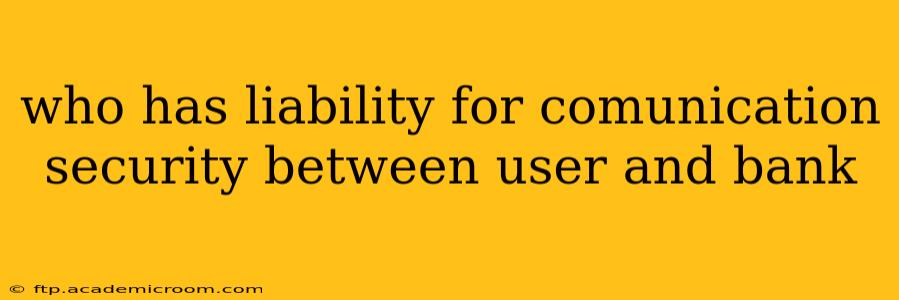Who Has Liability for Communication Security Between User and Bank?
The liability for communication security between a user and their bank is a complex issue, shared between the bank and the user to varying degrees depending on the specific circumstances and jurisdiction. There's no single, simple answer, but we can break down the responsibilities and factors involved.
Understanding the Shared Responsibility Model
Most modern banking systems operate on a shared responsibility model. This means both the bank and the user have obligations to protect the security of their communications. The bank's responsibility is primarily focused on providing a secure infrastructure and systems, while the user's responsibility centers on protecting their own credentials and devices.
The Bank's Liability:
Banks are legally obligated to maintain a reasonable level of security for their systems and customer data. This includes:
- Secure infrastructure: Implementing robust security measures like firewalls, intrusion detection systems, encryption, and regular security audits to protect against cyberattacks and data breaches.
- Secure communication protocols: Utilizing secure protocols like HTTPS and TLS to encrypt communication between the user and the bank's servers.
- Authentication and authorization: Implementing strong authentication methods (like multi-factor authentication) to verify user identities and prevent unauthorized access.
- Employee training: Ensuring their employees are properly trained to handle sensitive customer data and follow security protocols.
- Incident response plan: Having a plan in place to address security incidents and data breaches promptly and effectively.
Failure to meet these obligations could lead to legal repercussions if a security breach occurs, resulting in customer losses. The extent of the bank's liability will depend on the specifics of the breach and whether the bank acted negligently.
The User's Liability:
While banks bear significant responsibility, users also have a critical role in securing their communications:
- Strong passwords: Choosing strong, unique passwords and avoiding password reuse across different accounts.
- Multi-factor authentication (MFA): Enabling MFA whenever available to add an extra layer of security.
- Software updates: Keeping their operating systems, browsers, and other software up-to-date with security patches.
- Antivirus software: Using reputable antivirus software to protect against malware and phishing attacks.
- Phishing awareness: Recognizing and avoiding phishing attempts that try to steal login credentials.
- Device security: Protecting their devices from unauthorized access with strong passwords or biometric authentication.
- Secure Wi-Fi: Avoiding the use of public Wi-Fi for sensitive banking transactions.
Failure to take these precautions could make a user vulnerable to phishing scams, malware infections, or other attacks, potentially leading to financial losses. In some cases, a user’s negligence might limit their ability to claim compensation from the bank in the event of a security breach.
H2: What are the common causes of communication security breaches between users and banks?
Common causes include:
- Phishing attacks: Deceptive emails or websites that trick users into revealing their login credentials.
- Malware infections: Viruses or other malicious software that can steal data or control the user's device.
- Weak passwords: Easily guessable or reused passwords that make accounts vulnerable to attacks.
- Lack of MFA: Failing to enable MFA leaves accounts susceptible to unauthorized access even if login credentials are compromised.
- Unpatched software: Outdated software with known security vulnerabilities can be exploited by attackers.
- Use of insecure Wi-Fi: Public Wi-Fi networks are often unsecured and can be intercepted by attackers.
H2: What steps can banks take to improve communication security?
Banks can enhance security by:
- Investing in advanced security technologies: Implementing more sophisticated security systems and protocols.
- Improving employee training: Ensuring staff are well-trained on security best practices.
- Strengthening authentication methods: Utilizing stronger authentication methods like biometric authentication.
- Implementing regular security audits: Conducting regular security assessments to identify and address vulnerabilities.
- Improving customer education: Educating customers on best practices for online security.
H2: What legal recourse do users have if their communication with their bank is compromised?
The legal recourse available to users will depend on the specific circumstances, jurisdiction, and the bank's security practices. In some cases, users might be able to sue the bank for negligence if they can demonstrate the bank failed to meet its reasonable security obligations. However, demonstrating negligence can be challenging.
Conclusion:
Liability for communication security between a user and their bank is a shared responsibility. Both the bank and the user have obligations to protect the security of their communications. While banks are responsible for providing a secure infrastructure, users must also take steps to protect their own credentials and devices. Understanding these shared responsibilities is crucial for both banks and their customers to minimize the risk of security breaches and financial losses.
